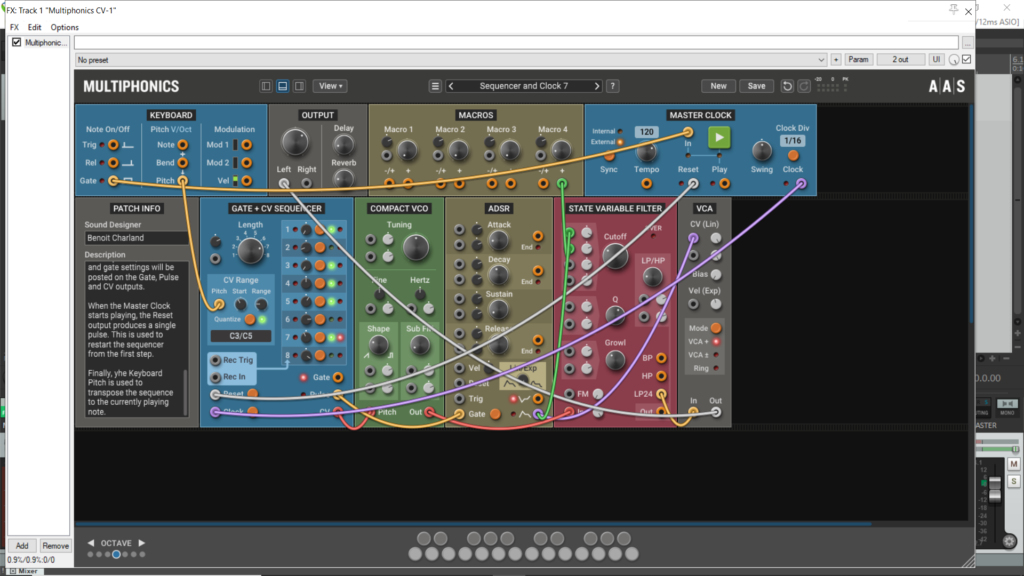The software realm boasts multiple modular synth apps and plugins for both the iOS and desktop platforms. We previously covered miRack and Audulus on iOS; I experimented with other plugins for the desktop as well. The Moog Modular (Arturia version) and Model 15 definitely stand out on PC and mobile respectively.
When I heard Applied Acoustic Systems crafted their own modular synth environment, Multiphonics CV-1, I immediately needed to check it out. After all, Objeq Delay remains one of my favorite effects plugins; leveraging physical modeling to sufficiently mangle any sonic source in highly musical ways. CV-1 also includes a filter variant of Objeq as a module. I’m sold!
Multiphonics CV-1 Features
- Modular Synth Environment With Great Sonics and a Clean Interface
- A Host of Modules: Oscillators, Filters, Envelopes, Mixers, Sequencers, Etc.
- The AAS Objeq Filter Module Opens New Worlds of Sound Design
- Creating Your Own Patches is Easy and Fun
- A Copious Number of Patches Spanning a Wide Array of Sonic Categories
- Tutorial Patches Help You Learn Patch Architecture
- Each Patch Has Built-In Delay and Reverb
- Plugin Compatible With All Major DAWs, Plus a Standalone Version
- Available For Mac OS X (10.11 and Later) and Windows 10 PCs
- Only $99 From AAS!
If you remain curious about modular synthesis, but don’t want to spend thousands of dollars on a hardware system, check out CV-1. It offers a great pathway for learning the possibilities of this limitless synthesizer frontier. Once again, the inclusion of the Objeq Filter module also provides a host of unique sonic possibilities, especially in the percussion realm.
The Clean CV-1 Interface Makes It Easy to Use
Unlike many other modular synth software applications, Multiphonics foregoes a skeuomorphic interface. Instead, it features a clean design, similar to the rest of the AAS arsenal. This graphical approach makes sense, as CV-1 doesn’t feature software versions of real-world hardware modular synth modules. It also plays a key role in the ease of use of the app.

Surrounding CV-1’s virtual synth rack are four panels. The left panel lets you navigate the patch or module browsers. The right panel provides access to the app’s settings or the built-in delay and reverb effects. The bottom panel includes a virtual keyboard. Finally, the toolbar resides in the top panel, which lets you hide the other three panels. This extra screen real estate helps when navigating a large patch.
The toolbar also lets you switch between patches, access the excellent CV-1 help system, and includes a level meter. Undo/Redo switches and the ability to control the opacity of patch cables also exist. Again, this clean interface makes playing existing patches and creating new ones an easy process.
I Dream of Virtual Wires
Multiphonics CV-1’s patch creation process offers an easy way to create a vast array of sounds from scratch, as well as modify existing patches. The application includes a host of patches created by some of the top sound designers in the industry. There are also tutorial patches to help you learn the basics. Additionally, nearly all of the sound designer patches include the Patch Info module describing their work – also great for learning.
CV-1 boasts a copious amount of sonic possibilities. The Classic VCO module includes an FM Input which makes creating patches using that synthesis type a simple process. Check out the robust supply of example patches to get a few insights on FM synthesis for your own work.
There are a host of modules covering the full range of modular synthesis. These include oscillators, filters, mixers, envelopes, and more. Each patch includes a few standard modules, like Keyboard, which provides note, gate, and modulation signals. The Output module sets overall levels with sends to the embedded reverb and delay.
The Macro module provides controllable modulation throughout the patch. At a minimum, map the knobs on your MIDI controller to the four macro controls. Finally, a Clock module is used for sequencing and other time-based fun. Of course, CV-1 supports both internal and external clocks with swing.
The Objeq Filter Module Won My Heart
As mentioned earlier, CV-1 also includes the filter from Objeq Delay as a module. Check out the beat from the Church of Hed track, Sandstoned No. 2 to get a feel for the sonic mangling capabilities of Objeq Delay.
Once again, the inclusion of Objeq Filter is a gamechanger for building your own sound mangling patches, especially those with a world music or percussion focus. Of course, the “world” in question needn’t be in our own solar system. As a modular system without versions of real-world Eurorack modules, Objeq Filter gives CV-1 its own unique sonic depth that likely enhances your interest in the synth.
Of course, building a full range of classic analog patches lies squarely within CV-1’s wheelhouse. Cool examples abound within the presets, with explanations provided by most of the patch creators.
Once again, if you are interested in modular synthesis but want to explore the software realm before spending on hardware, Multiphonics CV-1 belongs on your shortlist. It serves as a perfect introduction to the techniques and sound domain of the Eurorack world. Notably, the standard layouts provided by the included modules make patch design easier. Even Eurorack grognards need to check out the unique sound possibilities of the Objeq Filter module. Once again, it’s a sonic gamechanger. We wholeheartedly recommend Multiphonics CV-1 for anyone looking for a software-based modular synthesis platform. It’s that good!
